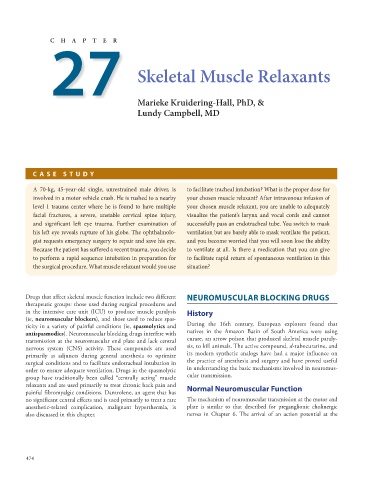Page 488 - Basic _ Clinical Pharmacology ( PDFDrive )
P. 488
27 Skeletal Muscle Relaxants
C H A P T E R
Marieke Kruidering-Hall, PhD, &
Lundy Campbell, MD
C ASE STUD Y
A 70-kg, 45-year-old single, unrestrained male driver, is to facilitate tracheal intubation? What is the proper dose for
involved in a motor vehicle crash. He is rushed to a nearby your chosen muscle relaxant? After intravenous infusion of
level 1 trauma center where he is found to have multiple your chosen muscle relaxant, you are unable to adequately
facial fractures, a severe, unstable cervical spine injury, visualize the patient’s larynx and vocal cords and cannot
and significant left eye trauma. Further examination of successfully pass an endotracheal tube. You switch to mask
his left eye reveals rupture of his globe. The ophthalmolo- ventilation but are barely able to mask ventilate the patient,
gist requests emergency surgery to repair and save his eye. and you become worried that you will soon lose the ability
Because the patient has suffered a recent trauma, you decide to ventilate at all. Is there a medication that you can give
to perform a rapid sequence intubation in preparation for to facilitate rapid return of spontaneous ventilation in this
the surgical procedure. What muscle relaxant would you use situation?
Drugs that affect skeletal muscle function include two different NEUROMUSCULAR BLOCKING DRUGS
therapeutic groups: those used during surgical procedures and
in the intensive care unit (ICU) to produce muscle paralysis History
(ie, neuromuscular blockers), and those used to reduce spas-
ticity in a variety of painful conditions (ie, spasmolytics and During the 16th century, European explorers found that
antispasmodics). Neuromuscular blocking drugs interfere with natives in the Amazon Basin of South America were using
transmission at the neuromuscular end plate and lack central curare, an arrow poison that produced skeletal muscle paraly-
nervous system (CNS) activity. These compounds are used sis, to kill animals. The active compound, d-tubocurarine, and
primarily as adjuncts during general anesthesia to optimize its modern synthetic analogs have had a major influence on
surgical conditions and to facilitate endotracheal intubation in the practice of anesthesia and surgery and have proved useful
order to ensure adequate ventilation. Drugs in the spasmolytic in understanding the basic mechanisms involved in neuromus-
group have traditionally been called “centrally acting” muscle cular transmission.
relaxants and are used primarily to treat chronic back pain and Normal Neuromuscular Function
painful fibromyalgic conditions. Dantrolene, an agent that has
no significant central effects and is used primarily to treat a rare The mechanism of neuromuscular transmission at the motor end
anesthetic-related complication, malignant hyperthermia, is plate is similar to that described for preganglionic cholinergic
also discussed in this chapter. nerves in Chapter 6. The arrival of an action potential at the
474

